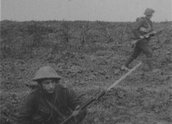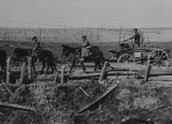


Bapaume to Bullecourt (1917)
Synopsis
In March 1917, Australian troops occupy Bapaume in northern France, after German troops have withdrawn to stronger defences along the Hindenburg Line. Troops advance across a desolate No-Man’s-Land, past lines of barbed wire. Near the road from Albert to Bapaume, engineers and Australian Pioneers lay light railway tracks to assist the advance. They repair roads and build detours around craters left by the German mines. A tank moves up with the infantry.
On 17 March 1917, the Australians enter Bapaume, with many buildings still burning, the fires set by departing German troops. An Australian Army band plays for troops in the town’s main square. A few days later, the town hall has disappeared, destroyed by a delayed-action mine which buried a number of Australian troops. Working parties dig for survivors. German shells rain down on a village held by Australian troops. Australian machine gunners bring down an enemy aeroplane. Australian artillery pounds German positions at Bullecourt, further north, part of the Hindenburg Line.
Curator’s notes
Charles Bean, the official historian of Australia’s role in the First World War, was a stickler for accuracy in all things, but especially photography. It is strange then that the films taken under his supervision from 1916 to 1918 have so many inaccurate or contradictory titles. The same sequence may turn up in two or even three different films, labelled differently. One reason might be that the cine films were primarily intended for propaganda purposes, for immediate use as recruiting tools back home, but there is little evidence that many were widely shown during the war in Australia. It appears that Bean did not initially have control over the final assembly, even though he tried to oversee the production of some of the earliest films (see With the Australians in France 1916, and Australia in France, Part One, c1918). He did attempt to reassemble some material with accurate titles immediately after the war, but even then, his accuracy has been questioned by modern historians (see With the Dardanelles Expedition, c1915).
Bapaume to Bullecourt illustrates the problems of relying too much on the titles. The AWM holds two films which share many of the same sequences, but with differing titles. Troops who are Australians in one film are labelled as South Africans in the other, for example. The online publication of Bean’s diaries makes it easier to pinpoint the dates and places in which certain scenes were filmed, but not what happened to those sequences in subsequent use.
Bapaume to Bullecourt was largely filmed in late March of 1917, probably by Herbert Baldwin, an English press photographer who was the first official Australian war photographer. Baldwin joined Bean in November 1916 after Bean campaigned to have a person appointed solely for Australian use. The Canadian forces had succeeded earlier that year in having a serving soldier, Harry Knobel, appointed as their own official photographer. Bean was intensely frustrated by rulings from British General Headquarters that he was not allowed to take photographs himself (as he had been on Gallipoli) and that he had to use the accredited British army photographers, when he could ‘borrow’ them. By lobbying at the highest levels, Bean recruited Herbert Baldwin, who was already an experienced war photographer. He had covered the Balkan War in 1912–13, and had just returned from Mesopotamia. Baldwin wrote a book about his experiences in the Balkans, A Photographer in Thrace (1913).
Bean and Baldwin worked closely together for most of the next eight months, until Baldwin’s health collapsed during the barrage at Messines in June 1916 (see The Australians at Messines, 1917). Baldwin took 540 glass-plate negatives during that time – some of the most beautiful images of the war, according to curators at the Australian War Memorial. He also shot cine film, but whether he was the only source of moving images for Australian usage is debatable. There were other British cine cameramen operating on the Western Front and Bean had no reservations about using their work, if they had taken pictures of Australian troops. Thus we don’t know if Baldwin shot all of Bapaume to Bullecourt, although it’s highly likely.
The film covers more of Bapaume than Bullecourt – not surprising perhaps, given that the fighting for Bullecourt was much more dangerous to film and that Baldwin was struck down by dysentery during much of the Bullecourt fighting. An assistant had to step in to take photos, according to Bean’s diary. On 16 March, the Germans withdrew from Bapaume to stronger defensive positions, along what the British would call the Hindenburg Line. As they went, they destroyed anything that could be used by the advancing British. When the Australians entered Bapaume, a once pretty regional centre north of the Somme Valley, they found it burning and booby-trapped. German troops had piled furniture and poured tar on top to make the fires burn faster. They bombed their own dugouts to make them unusable. Under the town hall, they planted a large mine, which exploded a week later, killing 25 Australian soldiers. The first scenes here show Bapaume burning on 17 March, the day after the German forces withdrew.
The houses are still smoking two days later as an Australian Army band from the 5th Infantry Brigade plays in the town square. A still photograph taken on the same spot at the same time became one of the most famous photographs of the war in Australia, a symbol of the Australian ‘fighting spirit’ (E00426). Moving images from a week later show the aftermath of the delayed mine, as troops dig through the remains of the town hall for the bodies of their mates. Bean’s diary for 17 March (AWM38, 3DRL606/73/1, pp 32-34) records that he and Baldwin rushed to Bapaume once they heard that the town had been taken. Ernest Brooks, an official British photographer who had shot pictures for Bean earlier in 1916, accompanied them. Bean and Brooks had clashed on numerous occasions since meeting on Gallipoli, because Brooks was not averse to fabricating his pictures, to increase dramatic impact. At Bapaume, he appears to have tried to scoop Baldwin, again incurring Bean’s disapproval. On 18 March, Bean’s diary records this entry, ‘Baldwin worked all night and took his photos to GHQ with my articles today. Brooks had very meanly, and against all GHQ’s own arrangements, got in before him.’ (18 March 1917, p 34).
Bean does not elaborate, but the inference is that Brooks, an experienced and competitive photographer for the London newspapers, had submitted his photographs earlier, presumably in an attempt to have them published first. All British photographs of the war came through official channels – for censoring, then dispersal to British and allied newspapers. Brooks and Baldwin did not work for the newspapers, but for the British General Headquarters. Still, the sense of pre-war competition appears to have lived on, at least in Brooks’s mind. Bean does not record the outcome of this episode, but it raises the possibility that Brooks may have taken a cine camera into Bapaume. That is unlikely, given the cumbersome task of carrying even a stills camera, but it makes it slightly less sure that the moving images we see here can be attributed with absolute certainty to Baldwin alone.
On the question of whether Bean had control over the final assembly, Ian Jackson, a curator at the Australian War Memorial, writes that it’s true that Bean did not have control, given his frustration at the way some of his film was botched in London:
However, in a sense it is not clear why Bean should have had control over the final assembly. While he had operational control over the photographers in France as well as being Official Correspondent, he was not head of the Australian War Records Section, which, led by John Treloar from its headquarters in Horseferry Road in London, was responsible for cataloguing, preserving and distributing all historical records of the AIF. While the AWRS relied heavily on Bean for caption information, and a large number of captions and titles in the AWM collection can be presumed to have been written by him or his assistant Arthur Bazley, he did so out of interest and his concern to see as accurate as possible a record, not because it was his job. The films were taken under his supervision, but of course he was not always present at filming; and the extent of Bean’s involvement in editing and titling films (except the one we have his notes for) must be a matter for conjecture. There is a risk of assuming that Bean must have acted as producer to all of the Australian films, rather than as a kind of historical consultant, and thus perhaps of downplaying the role of the AWRS and other figures such as Henry Casimir Smart, who was in charge of the Australian government’s publicity at Australia House in London. By the end of the war there were 500 people working for the AWRS so it was a big operation; Bean’s relationship to it was close, but he was not directly part of the organisation.
- Overview
- Curator’s notes
- Video 3 clips
- Find a copy
- Make a comment
- Map
- Extras
- Add your review



